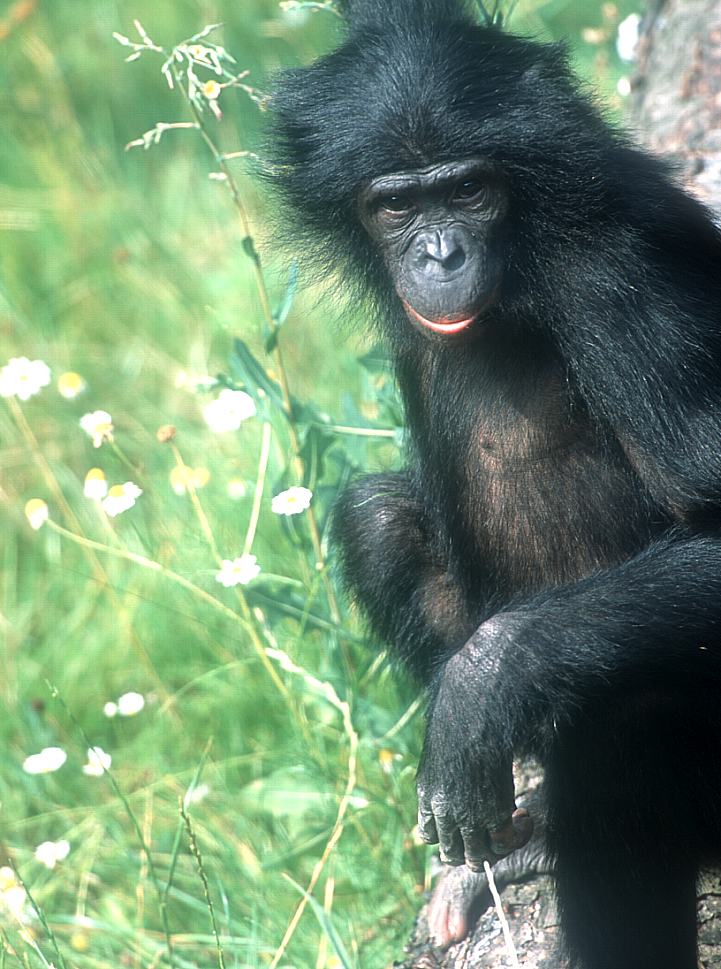Unraveling the Bonobo's Genome, and its Secrets

Ulindi, a female bonobo at the Leipzig Zoo in Germany, has had her genome sequenced, researchers report today (June 13), making bonobos the last of the great apes to have their genomes mapped. The resulting genetic code may help unlock the secrets that separate humans — physically, intellectually and behaviorally — from our closest primate relatives.
Bonobos are often seen as the chimpanzee's peaceful cousin. The two primates look very similar and are very closely related, but for some reason chimps resolve conflicts with war while bonobos prefer sex to resolve arguments. Previous studies have also shown that bonobos are more generous with food than chimps are.
"Bonobos and chimpanzees are very different in their behaviors," study researcher Kay Pruefer, of the Max Planck Institute for Evolutionary Anthropology, in Germany, told LiveScience. "While we are not yet able to look at the genome and know why that is, it's important to know the differences between bonobos and chimpanzees to tease apart what genes might be responsible for that."
Ulindi's genetic map
What stood out for the researchers were the genetic similarities found between humans and both chimps and bonobos. [Animal Code: Our Favorite Genomes]
They found that the Ulindi's genome is about 99.6 percent identical to the chimpanzee genome and 98.7 percent identical to the human genome — basically they are just as related to humans as chimpanzees, which have about 1.3 percent of their genome different than ours.
However, a stretch of DNA that covers about 1.5 percent of Ulindi's genome matches more closely with the genome of humans than to their closer genetic relative the chimps. The chimps, on the other hand, have a different section of the genome that's more similar to humans than to bonobos.
Sign up for the Live Science daily newsletter now
Get the world’s most fascinating discoveries delivered straight to your inbox.
"There are certain parts of the human genome where you can see the humans are more closely related to bonobos than chimpanzees and other parts where they are more closely related to chimps than bonobos," Pruefer said. "This is a much larger amount than we previously thought."
The primate split
The sequenced genomes will help researchers figure out how the primates become such distinct species. For instance, scientists have hypothesized that the formation of the Congo River separated the ancestors of chimpanzees and bonobos, leading to their separate species. The genome results support this idea in that there was no sign of any interbreeding.
The new genome map suggests that about 4.5 million years ago the common ancestor of all three primates (humans, chimps and bonobos) split off from the rest, and developed into humans.
Then about 2 million years ago, the remaining individuals were divided by the Congo River, and started evolving separately. They became separate species — chimpanzees and bonobos — about 1 million years ago.
"In this short time of a million years they developed these vastly different behaviors," Pruefer said. "Which is intriguing because it means these behavioral patterns can change quite rapidly."
The researchers haven't gotten a chance to look closely at the genes and genetic changes that separate these three hominids, but they are hopeful that careful analysis of these regions may help them understand why chimpanzees and bonobos are so similar, yet so different.
The study was published today, June 13, in the journal Nature.
Follow Jennifer Welsh on Twitter @microbelover or LiveScience @livescience. We're also on Facebook & Google+.
Jennifer Welsh is a Connecticut-based science writer and editor and a regular contributor to Live Science. She also has several years of bench work in cancer research and anti-viral drug discovery under her belt. She has previously written for Science News, VerywellHealth, The Scientist, Discover Magazine, WIRED Science, and Business Insider.











